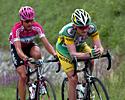
Recently on Cyclingnews.com |
View from the lab - Ric Stern's Tour de France sports science
|
|
British ABCC coach Ric Stern (www.cyclecoach.com) is a regular contributor to Cyclingnews' Form & Fitness section along with being a full time coach. Still an active rider when time allows, Ric will be providing a physiological insight into the challenges that face the riders in the Tour.
July 20, 2006: Why data is useful

|
I was going to write this diary report about possible reasons why Floyd Landis lost a huge chunk of time yesterday, however, after today’s stage, which is possibly one of the most exciting I’ve witnessed, I’m going to write about how brilliantly Floyd rode and, about some power meter data.
Many of us will have seen Floyd on the TV riding his BMC bike to success, and if we’ve not seen him on TV on the bike, there are plenty of photos at Cyclingnews! Almost out of sight, at the back of the bike is the Power Tap hub. At the front of the bike is the yellow Power Tap computer. As I understand it, Floyd does all his training and racing with the Power Tap to collect this most vital data metric.
Over the previous columns, and last year, I’ve regularly mentioned about power output, and made estimates of what power the riders may be producing. I’ve been collecting power data since 1994, and have data from world-class pros to more regular riders like you and I. Over that time period I’ve had many people say to me that they can’t race with a power meter because it’s too heavy. No matter how I’ve tried to convince them (some riders) don’t want to give their competitors a ‘head start’.
However, now we see Landis winning one of the most mountainous stages in the Tour with his Power Tap. A few extra grams really won’t make any difference, especially when you look at the data it can give you and how you can use that to prepare for the next Tour de France.
In a basic sense after using it to help pace yourself, you can use the data collected from it to analyse, amongst other things, how well you climbed the mountain in your races. The mountain could be Alpe d’Huez or the local climb that takes 5-minutes in a 3rd category race – the principle will be the same.
You ascertain the average power over the crucial point. Let’s suppose you average 373 W up Alpe d’Huez and arrive in a time of 42 minutes. We’ll pretend that you finished 60 seconds back from the winner. Next year you want to be with the winner or ahead of them, and by using some online calculators (I like www.analyticcycling.com) you can alter the data inputs to arrive at your time and power output.
So we know (in this example) that the power you needed is 373 W (this came from your Power Tap, SRM, or similar), we know that the road has an average grade of 7.9%, and the climb duration is 13.9 km. Your power meter also tells you your average speed (or you can calculate it yourself), and in this example it is 19.86 km/hr or 5.51 m/s (divide by 3.6 to arrive at a m/s value, which you’ll need for analytic cycling). Calculate the mass of yourself and your bike and your kit. Enter the data and then alter the unknown data units to arrive at the power you needed.

|
Once that’s done you can then go about estimating what power you’d need to travel 60 seconds faster or at a speed of 20.34 km/hr or 5.65 m/s. Keeping everything else the same, alter the speed from 5.51 to 5.65 m/s, and you’ll arrive at your goal power output, of 384 W, or an increase in power of just under 3%. This could be your goal for several months down the line, which would be specific and measurable.
At the same time, you can also see how the power would pan out if you cut out chocolate and lost 1 kg (4 W less).
You’d then set up a training programme to help increase your power, or get a coach to help with this, and if it’s a realistic goal and time based you have something to work towards. Obviously, if you’re a regular cyclist such as myself who can only manage around 270 W for such a climb (and who is heavier than my imaginary cyclist who has whizzed up the Alpe in 42 minutes) you’d arrive at the summit in 57 minutes and 55 seconds, and setting a goal of 380 watts is unlikely to be realistic. Which is a shame, as I’d really like to win the Tour?
By using metrics invented by Doctor Andy Coggan, such as Normalized Power* and Training Stress Score**, certain elite coaches are able to track acute and chronic training loads. This allows these coaches to see how and when riders will be at their fittest (and their weakest) and to plan training accordingly, and to help periodise training.
*When you ride with a power meter, one of things you initially see is that power can be quite variable or stochastic. Momentary power isn’t therefore of much use (e.g., as you accelerate out of a corner you could briefly hit 700 W, which doesn’t really tell us anything about the cyclist). However, by using an algorithm created by Andy Coggan we can view normalized power, which essentially is the power you’d ride at if your power output were steady and not fluctuating. Depending on how variable your power was your normalized power could be significantly different from your average power (e.g., average power in a flat time trial or on the trainer is likely going to be the same or similar to normalized power, average power in a criterium, road race or mountain stage will be significantly different to normalized power)
**To quantify training loads Training Stress Score (TSS) was developed, based on normalized power, and is a measure of power x duration x exercise intensity. By setting TSS to read 100 points for a flat out 1 hour time trial you can assess how fatiguing (or not) a training session is, and use it to measure overall training fatigue
To view Normalized Power and TSS we have a free Excel diary application by James Huntington, on our web site at cyclecoach.com/pageID-downloadPages-Normalised_Power_TSS_IF.htm. There is also commercial software to do this.
Going back to Floyd, and his huge disappointment on stage 16, it would appear that perhaps one reason why he did so badly was that he simply overheated. In stage 17 he poured lots of water over himself, potentially to try and keep core temperature down, and feel more comfortable. One thing is for certain; very hot weather can have an adverse effect on the power output that you can sustain. How much it affects you will vary significantly from person to person and how well they tolerate heat. Keeping fluids up with cold dinks (as mentioned in some of the early reports) is very important.
During the stage, the rather excellent skills of the motorbike cameraman managed to film Landis’ Power Tap display and we could see that his power was around 370 W up the Col de Joux Plane, while he rode at about 20 km/hr. Meanwhile, SRM have been showing live telemetry every day in the Tour. One thing is for sure, previously, people have told me they can’t race with a power meter because it’s too heavy. I’ve frequently told them that the data is vital to peak performance and is very useful. I feel that after yesterday's stage, seeing Landis with a Power Tap decimate the field that no one will be saying they’re too heavy anymore!

